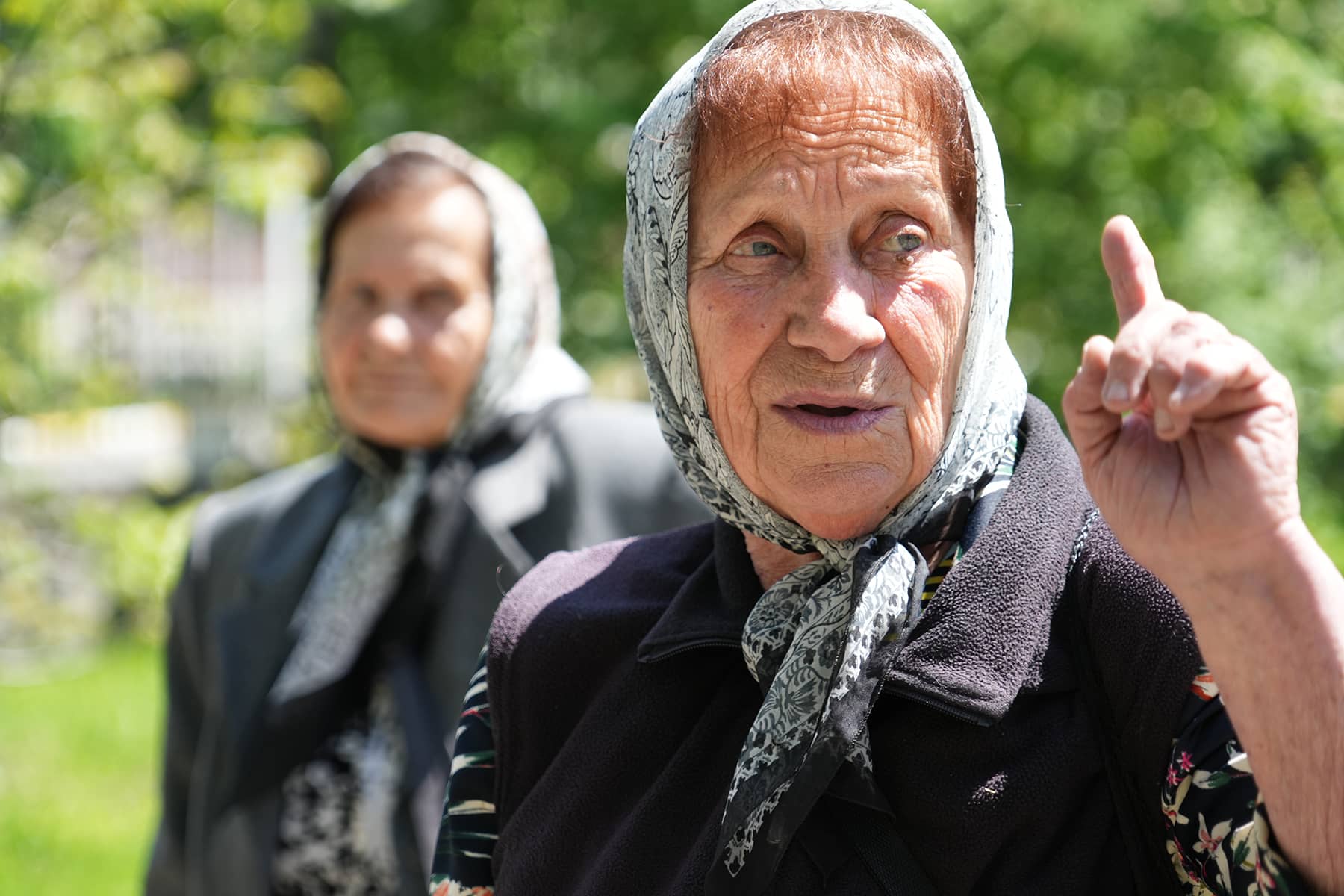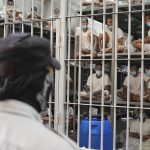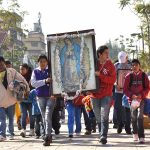
In the first days of April, along the grounds of the Church of St. Andrew and Pyervozvannoho All Saints in Bucha, a 45-foot long trench was discovered. The first evidence of excavation dated back to March 10. The site was a mass grave of 67 bodies.
By the time our team from Milwaukee Independent arrived at the site of the mass burial, the bodies had been removed by authorities for identification and proper interment. Much of the evidence of the Russian massacre had been already collected, and the area cleaned. But landmarks, like the church, remained haunting icons that marked where the Russian brutality had taken place.
That was where we met two grandmothers, Tetyana and Olena, who were local residents. Both women had remained in Bucha during the occupation, refusing to leave.
“Our city was quickly captured by the Russians,” said 84-year-old Tetyana. “I live on the outskirts, so the evacuation buses did not come to our location. I am old and it was too far to go to the evacuation center. But even if I could, I would not have gone. I grew up here, and I have lived here all my life.”
From the beginning of the Russian occupation on February 26 until its liberation over a month later, the town was completely inaccessible. Only when Ukrainian troops arrived in Bucha were the dead bodies of civilians found lying in the streets, victims of extrajudicial killing by the invading troops.
According to local authorities, approximately 1,000 bodies have been recovered from the town, including 31 children. Many bodies were found mutilated and burnt, with reports that girls as young as fourteen were raped and killed by Russian soldiers.
“I heard about the atrocities of the occupiers, but did not see it. They came to us several times, inspected the apartment but not much more,” said Tetyana. “As soon as the occupiers came in, all the shops stopped working. Gas, water, light – there was nothing. We ate what was in the refrigerator and in the pantry, ate the very last of provisions. Sometimes we starved. Food was cooked in the yard, the fire was lit with bushes. Bread was not seen for more than a month. That’s how all of us, together with the neighbors who stayed, shared food and managed to survive.”
Russian troops had not allowed residents to bury the dead, and were killed when trying. Because the local cemetery was in the line of fire and in a dangerous area, land behind the church was used for a mass grave.
The torture, death, and looting by Russian troops has been classified as war crimes, and acts of genocide against Ukrainian civilians.
“When the occupiers were driven away, the mayor of Irpin was the first government official to come to us with humanitarian aid on April 1,” added Tetyana. “I don’t know where our mayor was.”
With the departure of Russian forces also came anger from residents of Bucha. Many appreciated the support from the nearby town of Irpin, and felt their own mayor had abandoned them. Anatoly Petrovich Fedoruk, who had been Mayor of Bucha for more than twenty years, was accused of betrayal and flight.
According to translated social media posts, “Fedoruk handed over the city and disappeared. He was not even involved with the evacuation. He was nowhere in the town, and was never seen during the occupation. There was no word from him at all since early March.”
In the aftermath of the Bucha massacre, many officials have been reluctant to publicly criticize Fedoruk. But it has been a bitter pill for some Bucha residents, who see him as a traitor that gets media attention he did not deserve, and credit for bravery he did nothing to earn.
Series: Reports from Ukraine
- Reports from Ukraine: Traveling from Milwaukee to a country at war just to take a vacation from America
- Images from Ukraine: Latino artist travels to Irpin to paint mural inspired by "Echoes of Guernica"
- Images from Ukraine: Irpin residents welcome reissue of Russian Warship Stamp as latest sign of victory
- Stories from Ukraine: Wandering in the ruins of a shattered life after surviving Russia's invasion
- Images from Ukraine: Similar to the Alamo, martyred cities bought precious time to save a nation
- Stories from Ukraine: Tent camp offers shelter for displaced residents until Irpin can rebuild lost homes
- Images from Ukraine: Graveyards of Russian war machines show the scale of Putin's failure to seize Kyiv
- Images from Ukraine: Following the invasion convoy's 40-mile route and exploring an abandoned base
- Stories from Ukraine: Illegal weapons and proof of Russian War Crimes easily seen along streets of Irpin
- Images from Ukraine: How Irpin’s cemetery processed the staggering massacre of its local citizens
- Stories from Ukraine: Healing remains slow as Borodyanka residents recover from occupation
- Images from Ukraine: The deep scars of war remain visibly etched across the landscape of Borodyanka
- Interview with Oleksandr Markushin: Mayor of Irpin and the hero of a Hero City
- A Meeting of Sister Cities: Former and current Mayors of Irpin ask Milwaukee's business community for help
- Stories from Ukraine: Having a shared purpose helped Irpin's leaders protect the city and stop the invaders
- Stories from Ukraine: How Milwaukee helped a bakery feed hungry survivors in Bucha with fresh bread
- Stories from Ukraine: Bucha resident recalls how Russians turned neighborhood into a street of death
- Stories from Ukraine: How a mass grave of executions overshadowed accountability from Bucha’s leadership
- Images from Ukraine: Putin’s attack on Babyn Yar is a painful reminder of the broken vow of “Never Again”
- Images from Ukraine: An unexpected encounter with Jewish history and the bloody legacy of persecution
- Images from Ukraine: Listening to timeless voices of ethnic heritage etched in stone at Lychakiv Cemetery
- Images from Ukraine: The experience of attending a military funeral in Kyiv while children died in Uvalde
- Images from Ukraine: Stepping out of the fog of war to see the beauty of faith in ancient places of worship
- Images from Ukraine: The cities of Kyiv and Lviv were divided by history but remain united in identity
- Stories from Ukraine: Anya Nakonechna shares why the Lviv Opera is a symbol of her nation’s culture
- Images from Ukraine: A folk village where visitors can experience the life of past generations
- Images from Ukraine: Signs of renewal sprout from under Irpin’s rubble as city looks to the future
Yaroslav Zdyrko
Oleh Pinta and Halyna Salapata
Lее Mаtz
Lее Mаtz and Yaroslav Zdyrko
Milwaukee Independent editorial team for this special series: (UKRAINE) Lee Matz, photojournalist; Oleh Pinta, translator / reporter; Yaroslav Zdyrko, security / videographer; (MILWAUKEE) Halyna Salapata, logistics / translations.
Milwaukee Independent has reported on the situation in Ukraine since it was invaded on February 24. Coverage originally began with reactions and rallies from the local Ukrainian American community, and relationships with Milwaukee’s sister city of Irpin. Through partnerships and good journalism, sources were developed that enabled Milwaukee Independent to publish developments about the unprovoked war in realtime. In late May, a team from Milwaukee Independent spent nearly two weeks on the ground in Ukraine. The award-winning daily news magazine was the first and, at the time, only media organization to send staff into the country since the war began.
Reports from Ukraine: An extensive news series by Milwaukee Independent from a country at war
























